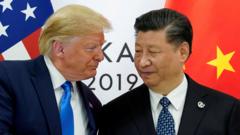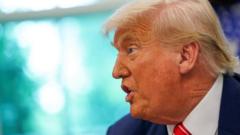With an eye on the upcoming NATO summit and the looming figure of former U.S. President Donald Trump, NATO Secretary General Mark Rutte is advocating for a significant increase in defense spending among member states. This inspection of European commitments to defense comes with the objective of enhancing military readiness and appeasing U.S. concerns over financial burdens shared among allies.
### NATO Leaders Push for Increased Defense Spending to Secure Trump’s Approval

### NATO Leaders Push for Increased Defense Spending to Secure Trump’s Approval
NATO Secretary General's proposal for a 5% defense spending target aims to satisfy U.S. demands while increasing European military capabilities.
Rutte's proposition to elevate NATO’s defense spending target to 5% of each member’s Gross Domestic Product (GDP)—a major leap from the existing target of 2%—reflects a strategic maneuver to avert criticism from Trump, who has consistently lambasted European nations for not contributing enough to collective defense. Historically, Trump has maintained a transactional view of international relations, prioritizing tangible commitments over diplomatic narratives.
During a press briefing in Brussels, Rutte emphasized that the increase will be critical to addressing threats, including those posed by Russia, while also hinting that it allows member nations some flexibility through "defense-related expenditure." This includes costs associated with military infrastructure and industry, a term broad enough to accommodate various budgetary needs without stringent accountability.
The logistics of such a commitment, however, are complex. With considerable divisions among NATO allies regarding current spending, Rutte’s approach calls for nations to grow their core defense budget to 3.5% of GDP while achieving the additional 1.5% through more ambiguous expenditures. The challenge lies not just in pledging these sums but in ensuring their actual realization over a long horizon—projected around 10 years without binding penalties for nations that fail to comply.
Critics may argue whether this proposal is a genuine step towards enhancing NATO’s deterrence capabilities or simply a political gesture to secure Trump's favor. Rutte’s discussion about employing yearly commitments from leaders seeks to prevent last-minute spending surges close to deadlines, commonly termed a "hockey stick" growth pattern.
As NATO members deliberate these changes, questions loom over NATO's ability to implement a robust enforcement mechanism to ensure compliance. Donald Trump, who previously criticized European defense budgets, is likely to continue influencing these discussions from outside formal politics.
In light of these developments, the upcoming meeting between Rutte and UK Prime Minister Keir Starmer could prove pivotal, especially since the UK's projected defense spending of 2.5% of GDP by 2027 falls short of the ambitious 5% target. U.S. Defense Secretary Pete Hegseth asserted confidence that many nations would meet this commitment, reinforcing a cooperative spirit among NATO allies while closely monitoring those yet to make definitive pledges.
As NATO prepares for this critical summit and examines its future strategies, the interplay of political will, national priorities, and geopolitical pressures will decidedly shape its defense landscape in years to come.
During a press briefing in Brussels, Rutte emphasized that the increase will be critical to addressing threats, including those posed by Russia, while also hinting that it allows member nations some flexibility through "defense-related expenditure." This includes costs associated with military infrastructure and industry, a term broad enough to accommodate various budgetary needs without stringent accountability.
The logistics of such a commitment, however, are complex. With considerable divisions among NATO allies regarding current spending, Rutte’s approach calls for nations to grow their core defense budget to 3.5% of GDP while achieving the additional 1.5% through more ambiguous expenditures. The challenge lies not just in pledging these sums but in ensuring their actual realization over a long horizon—projected around 10 years without binding penalties for nations that fail to comply.
Critics may argue whether this proposal is a genuine step towards enhancing NATO’s deterrence capabilities or simply a political gesture to secure Trump's favor. Rutte’s discussion about employing yearly commitments from leaders seeks to prevent last-minute spending surges close to deadlines, commonly termed a "hockey stick" growth pattern.
As NATO members deliberate these changes, questions loom over NATO's ability to implement a robust enforcement mechanism to ensure compliance. Donald Trump, who previously criticized European defense budgets, is likely to continue influencing these discussions from outside formal politics.
In light of these developments, the upcoming meeting between Rutte and UK Prime Minister Keir Starmer could prove pivotal, especially since the UK's projected defense spending of 2.5% of GDP by 2027 falls short of the ambitious 5% target. U.S. Defense Secretary Pete Hegseth asserted confidence that many nations would meet this commitment, reinforcing a cooperative spirit among NATO allies while closely monitoring those yet to make definitive pledges.
As NATO prepares for this critical summit and examines its future strategies, the interplay of political will, national priorities, and geopolitical pressures will decidedly shape its defense landscape in years to come.



















